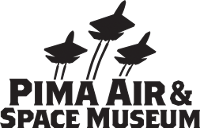The Pima Air & Space Museum
in Tucson Arizona
|
 |
The Pima Air & Space Museum is
located about a five-minute drive from Tucson airport and on the edge of
Davis Monthan Air Force Base. The museum is probably the largest
privately funded aviation museum in the world. |

Article and pictures by Ronald de Roij
When you enter the Pima museum the first thing you notice is the “gate
guard” . A statue called “beauty of flight” displaying three
YF-23, the plane that lost in the race for the US Air Force’s super
fighter to the now F-22 Raptor. The sculpture is also depicted in the
current logo of the museum
Unlike other aviation museums in the USA, the majority of displays at
Pima are outdoors. So, in the Tucson sunshine, you can wander around
outdoors and enjoy some aviation history
First opened in 1976, the museum had 70
artefacts' including aircraft, helicopters, and missiles in its original
collection. This has expanded now to more than 300 different aircraft
and a big collection off different artefact’s. The collection is diverse
one, ranging from small bi-plane, to the largest bombers in the US
inventory like the B-52 Stratofortress and B-36 Peacemaker. In recent
years the collection became more international with the additions off
aircraft not made in the USA like the Avro Shackleton and a collection
of MiG aircraft. .
It also helps that just across the road
lies Davis-Monthan Air Force Base, home to the world's largest
collection of U.S. military aircraft. Davis-Monthan is home to the 355th
Fighter wing flying the A-10 thunderbolts. But more importantly for the
museum is the Aerospace Maintenance and Regeneration Group (AMARG).
AMARG is tasked with updating the many planes and helicopters flown by
the air force. It also turns obsolete aircraft into training drones,
cannibalizes flying machines for parts and stores aircraft until they're
needed. It maintains a collection of almost every plane flown by the
U.S. over the past 50 years. As the museum shares a gate with the base,
it lets them move aircraft with relative ease from Davis-Monthan making
it a good source for new aircraft for the museum.
The museum has several hangars
dedicated to different indoor exhibits, and a very large outdoor area
with some of the larger pieces, the kind that won’t really fit inside a
building. The main hangar hosts a wide selection of aircraft and has a
few different themes.
There are two hangars dedicated to World War II aircraft, Hangar 3
dedicated to WWII European theatre, and houses such beauties as a B-24,
B-25, C-47 and A-26 along with a fighter exhibit. And Hangar 4 dedicated
to the Pacific theatre contains additional WWII aircraft, such as the
B-29, P-36 “King Cobra,” TBM Avenger, and the F4U Corsair
One off the hangers, is actually a
museum within a museum; the 390th Bomb Group Memorial. Centred on
the restored
B-17G Flying Fortress “I’ll Be Around” it pays tribute to
the men who fought for the 8th Air Force based out of England between
1943 and 1945.
The final exhibition building is The Dorothy Finley Space Gallery witch
has four areas of exhibits, X-Planes, Space Race, Outer Space and
Materials Technology.
On the edge of the museum is its own restoration center, to ensure that
every piece of aviation history is in tip-top condition. The restoration center, you peek inside and see how some of the aircraft look while
undergoing the change back to display condition. Next to this is the
museums own collection of stored aircraft used to repair or complete a
restoration.
Much of the Pima Air Museum’s outdoor
display is organized into groupings of aircraft with similar missions.
For example, right past the executive fleet is a nice display of the
“Century Series airplanes, including the F-100, F-101, F-102, F-104,
F-105, F-106 and F-107. Other groups of aircraft include heavy bombers,
(including three B-52 variations), attack aircraft, cargo, training,
reconnaissance, fighters, and electronic countermeasure aircraft. The
yard also has a line of MiG fighters, as well as various utility and
multi-role aircraft. Some unique aircraft fall into a category all their
own, such as the Aero Spacelines Super Guppy.
Pima Air & Space Museum hosts two other
interesting tours. One is a tour of the AMARC at Davis-Monthan AFB. This
tour lasts approximately one hour and is strictly guided. However, the
tour is quite complete; you get to see not only lots and lots of
airplanes, but also the facilities where planes are prepared for storage
or regeneration.
The other tour offered by the museum is a visit to a Titan missile silo.
The Titan Missile Museum National Historic Landmark is located at Titan
II ICBM Site 571-1 south of Tucson. This is the only publicly accessible
missile complex in the world.
Though none of the aircraft at the museum fly, the collection
represents a great few on aviation history, making it a place to go for
almost every aviation enthusiasts.
Each plane has a small QR code, which when scanned with a Smartphone
will take you to the history and description of the aircraft. To see the
museum properly you need to allow yourself plenty of time to wander
around.
|